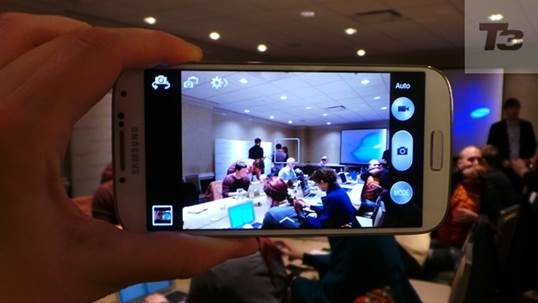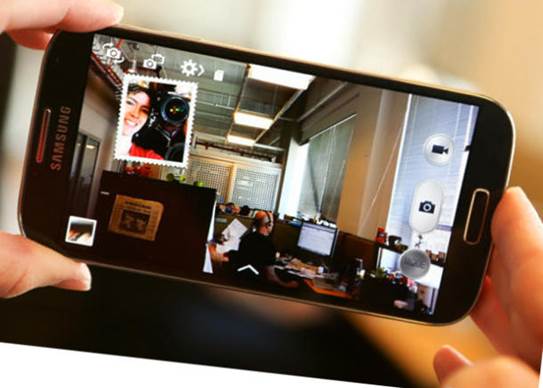Camera
Samsung has mass produced 8MP camera module
for the premium phones since Galaxy S2, so it’s almost a shock when the company
is ready to step up to 13MP model. As our experience with HTC One has
confirmed, the number of MP doesn’t create a magnificent camera, but of course
it doesn’t cause any damage (theoretically). And let’s be frank: there’re lots
of possibilities that the potential customers consider 13MP as more promising
as the prior 8MP module of Samsung – especially when you compare it to 4MP of
One, though Ultrapixel or not.

Samsung
has mass produced 8MP camera module for the premium phones since Galaxy S 2, so
it’s almost a shock when the company is ready to step up to 13MP model.
Besides, the camera on the back of GS4 uses
f/2.2 aperture, 4.235mm focal length and 69 degree angular view filed, 1/3.06inch
sensor provides 1.12 micron pixel size (compared to 2 micron on One). 13MP res
is set up at 4:3 aspect ratio, so 16:9 fans will need to lower to 9.6MP to have
wide-angled option. On the paper, the technical specs express a pretty stable
setting for a leading phone, but the performance does not always match the
technical specs – especially when we’ve used One a lot and realized that it’s
the one who raise the bar level in terms of lowlight result.
Samsung has made a step back and a step
forward with UI camera. Universal users will have no problem in adjusting the
interfaces, most of which have been moved over from Galaxy Camera: it includes
2 shutter buttons (one for image and one for video, like Sense UI of HTC),
gallery access on the top and a button on the bottom which lets you choose from
9 different modes, we will discuss in detail later. However, it lags behind a
little compared to the previous phones, which is in the messy menu settings
found on the top right corner of the viewfinder. Press it one time and you will
have a list of small shortcut options, as well as another cog-wheel icon
informing you that you have more settings to choose (you can also access this menu
easier by hitting the menu key from the main viewfinder).

Samsung
has made a step back and a step forward with UI camera.
Some camera modes also include an arrow
heading downward near the bottom of the viewfinder which as mode options to
choose. As these menus are different for each correlative mode – and completely
absent in some modes – you need time to get familiar to. Speaking about this, let’s
find out the new features Samsung has prepared for GS4.
New camera modes
As you may have known, Samsung founds its
reputation in providing a profuse number of settings which give you a shot to
change the images in many ways. With GS4, in deed it’s trying more, because a
few new camera modes has been added in. lots of amazing modes is for presenting
at a party but they’re less useful in somewhere else; however, we realize that
we only uses some modes regularly. We will discuss each mode by importance.
Dual-shot takes advantages of the 2 cameras
on the phone at the same time. At the moment you have a chance to capture
images or video with front and rear camera at the same time, creating
image-in-image effect which is identical to what we’ve seen on Optimus G Pro, as
well as many TV. The frame is smaller – which is the front camera overview by
default, though you can change the overviews easily at any time – you can resize,
move to whichever art of the viewfinder and have the shape of a box, a heart, a
stamp or a floating cloud, the style of Wizard of Oz, along with
something else. GS4 even lets you perform split-screen effect, with half screen
presenting the front and another presenting the back. We know that it’s an
advertisement trick, but it’s one of our four favorite features and we imagine
that lots of users will find the use for it.

Dual-shot
takes advantages of the 2 cameras on the phone at the same time.
GS4 also offers what we like to call “photobomb
mode”, official name of which is Eraser. It takes a series of images in 5 sec
and gives you the ability to remove any subject moving in the background. Sound
familiar? That’s because it does the same thing as Scalado Remove – we won’t be
surprised if Samsung cooperates with the company to make that happen. However,
it’s a useful feature, but has some disadvantages. First, you need to be in
this mode so that it can work. Second, sometimes it acts sophisticatedly, which
means that it doesn’t always choose all moving objects.

GS4
also offers what we like to call “photobomb mode”, official name of which is
Eraser.
Sound and Shot is a funny feature for
showing to your friend, but we don’t see any different use for it. In this
mode, the phone will take images and record 9 sec of audio immediately after
it. Then, that record will play back any time you view the images. The purpose
of this one is to record the moment of the event when it occurs, but we hardly
find many good use scenarios for it.
After that, you have Drama Shot, which
seems to be designed to impress the viewer. It captures a series of burst shots
– ideal if the object is moving from one side to another side of the viewfinder
– and combines them into one image. Let’s think about these old-fashioned “acting
shots” for the sport stars such as Michael Jordan preparing for a slam dunk, and
you will know the idea. In fact, this is the best use case for this special feature.

After
that, you have Drama Shot, which seems to be designed to impress the viewer.
The last mode we will discuss is Animated
Photo. With this one, camera records 1 5sec video clip and let you decide which
part of the screen is freeze and which one is animated. You can choose to make
the last result take place in a backward or forward circle, or let the clip
play again and again. In other word, this is a chance for you to create an
actually interesting GIF and have the specific parts of the screen frozen in
time. What you will use regularly? Of course not. an amazing feature that we
should have? Of course. To be honest, it’s hard for us to create something that
looks especially artistic, but at least it’s interesting to give a try.
However, it’s regretful that there’s no way for you to re-capture and redo your
masterpiece after it’s saved.
On this list of unique camera modes, GS4 also
provides HDR, Beauty Face, Best Face, Best Photo, Panorama, Sports and Night
mode. Most of the scene modes we’re familiar to in the old Samsung phones are
no longer exist – autumn colors, backlight, candlelight, sunset and some other
modes are now combined into auto mode of camera, which means that it’s smart
enough to choose the best scene based on specific situation.